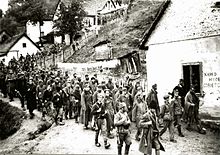Draft:Partisan-Chetnik War (1941-1945)
 | Draft article not currently submitted for review.
This is a draft Articles for creation (AfC) submission. It is not currently pending review. While there are no deadlines, abandoned drafts may be deleted after six months. To edit the draft click on the "Edit" tab at the top of the window. To be accepted, a draft should:
It is strongly discouraged to write about yourself, your business or employer. If you do so, you must declare it. Where to get help
How to improve a draft
You can also browse Wikipedia:Featured articles and Wikipedia:Good articles to find examples of Wikipedia's best writing on topics similar to your proposed article. Improving your odds of a speedy review To improve your odds of a faster review, tag your draft with relevant WikiProject tags using the button below. This will let reviewers know a new draft has been submitted in their area of interest. For instance, if you wrote about a female astronomer, you would want to add the Biography, Astronomy, and Women scientists tags. Editor resources
Last edited by Joy (talk | contribs) 41 hours ago. (Update) |
The Partisan-Chetnik War was an armed conflict between the Communist Yugoslav Partisans and the Monarchist Chetniks which lasted from 1941 (after the end of the Chetnik Partisan Alliance during the Serbian Uprising in the Second World War) until 1945 (the end of the Second World War in Yugoslavia)[1]
Background[edit]
Before the start of hostilities, the Partisans and Chetniks launched an armed uprising against Nazi-occupied Serbia after an incident in the town of Bela Crkva.
This uprising was remarkable as it created the first free territory in all of Europe during the Second World War and the first liberated city in the Second World War. At the beginning of the uprising, Chetnik-Partisan collaboration was an undeniable reason for the initial success of the uprising. This is why many historians consider this conflict a brotherly war. The most significant Chetnik-Partisan victories were in Užice, Loznica, Banja Koviljača, and Krupanj.[2]
This joint action would be the primary reason for the establishment of the Užice Republic.[3]

Start of the War[edit]
Course of the War[edit]
Chetnik Collaboration with the Axis[edit]
Battle of Serbia[edit]
End of the War[edit]
Aftermath[edit]
References[edit]
- ^ Tomasevich, Jozo (1975). The Chetniks. Stanford University Press. ISBN 978-0-8047-0857-9.
- ^ Pajić, S. (2015-11-28). "Decenijama palio sveću zaboravljenom heroju". Blic.rs (in Serbian). Retrieved 2024-06-23.
- ^ Минић, Милош (1993). Ослободилачки или Грађански рат у Југославији 1941-1945 (in Serbian). Агенција "Мир". ISBN 978-86-82295-01-3.

